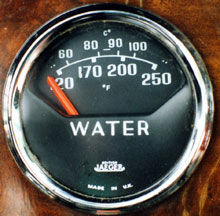Tiger Gauge Information

An Article by Stu Brennan
June, 2001
Page 3
- How it all works together
The heater in the gauge is in series with the sensor. This means that all the current that flows through the heater also flows through the sensor. At this point we have to get a bit technical. We have Ohm’s law, which is expressed as "V=IR", where Vis the voltage, I is the current, and R is the resistance. The voltage across a series string is equal to the current times the resistance. We can reform this equation into "V/R=I", which is more useful for this explanation.
V, our voltage is the constant 10Volts (average) from the regulator. R, the resistance, is the sum of the resistances of the gauge heater and the sender. As is indicated by the equation, as the temperature rises, the sender resistance decreases (see data above), causing the current to rise. The higher current causes the gauge heater to get hotter, causing the bimetal to bend more, moving the pointer further toward the hot (or "Full") end of the gauge.
- Using All Of This Information For Troubleshooting
Once you understand how the gauges and senders work, there are a number of easy tests that you can do to locate any failures. Keep in mind that these are automotive instruments, Lucas automotive instruments to boot, so do not get concerned if all of the results of any of your experiments do not match my numbers precisely. The gauges are intended to tell you if your car is running at about the normal temperature, a little bit hotter, or a lot hotter and maybe you better stop. Whether its running at 190F or 197F is not really important, but departures from normal levels are.
A quick check for Temp Gauge accuracy: As your car warms up, the coolant temperature rises to the point where the thermostat opens, and the temperature eventually stabilizes (For a while, at least). If you have a 190F thermostat, for instance, you should be able to watch your gauge come up to about 190F and stabilize. Though its not impossible, it is highly unlikely that the thermostat and the temp sender will have matching failures such that the gauge reads right with a bad thermostat. Remember that this is automotive, not NASA technology, and if you have a 5 or 10 degree difference, that's no big deal. Just remember where this stabilization normally happens on your gauge, and if it's suddenly happening higher or lower, you know you have a problem somewhere.
If Both Gauges Seem to Read HIGH, or both read LOW: Think for a minute. What’s the more likely failure mode? Both gauges, or both senders, or maybe one gauge and the other sender develop failure modes simultaneously that cause high readings? Or has ONE failure occurred that causes both gauges to read incorrectly? Does anyone remember that principle of logic that states that the simplest explanation is the most likely? What one thing can simultaneously effect both gauges? The voltage regulator, of course. Can you hear it switching? Measure it's output. A common failure mode for high readings is the regulator loosing its’ ground, which is through its’ mounting screw. Cleaning underneath and reinstalling might cure everything.
ONE Gauge Reads Funny. Is it the gauge or the sender? Remember that the Fuel and Temp gauges have the same works, but different scales. The same number of sender ohms to ground will result in the same pointer angle on both. For instance, is your fuel tank reading about half full, the pointer straight up? Swap the fuel sender lead to the temp gauge and you should get about a half scale reading on the temperature gauge. Or swap the temp lead onto the fuel gauge, and do the warmup/thermostat test described above. Does the pointer pause at about the right angle? If you get significantly different pointer angles then one of the gauges is faulty.
OHMMETER checks of the gauge: : Remove one of the wires from the gauge and measure it’s resistance, which should be in the vicinity of 60 Ohms. If it reads extremely high impedance, the heater is open, and you have a dead gauge. If you are lucky, it might be repairable. Carefully open the gauge (you have nothing to loose at this point) and check the internal wiring. You might find something to re-solder. If it’s the heater itself, then you might want to consider replacement or professional repair.
OHMMETER checks of the sender: If you know your thermostat temperature and trust it, here’s a simple test you can perform with an ohmmeter. Connect the ohmmeter between the sender lead and ground. Watch the readings while the car warms up. Do a little mental extrapolation to estimate what the resistance should be at your thermostat temperature, and watch for the thermostat to open and stabilize the temperature, as read on the ohmmeter.
If you have a way to accurately measure the temperature of water up to the boiling point, then you could place the sender in a pot of water and raise the temperature to boiling, recording resistance readings at various temperatures along the way.
A Challenge: Have you done any further investigations of the topics covered here? Do you know anything that could add to this tech tip? Then by all means send it in to Stu Brennan.
Stu Brennan
 **
**
